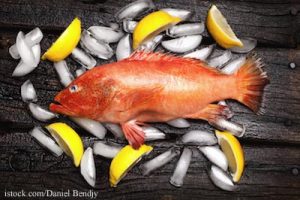You don’t often hear about ciguatera food poisoning, unless you are part of the fishing industry. This naturally occurring toxin found in fish can cause serious foodborne illness. Cooking does not deactivate the toxin, so even properly cooked seafood can make you sick. In the past few years, there have been several outbreaks and recalls related to this toxin.
 This type of food poisoning is responsible for the highest reported incidence of foodborne illness outbreaks linked to finfish around the world, according to a study published in Toxicon by Robert Dickey and Steven M. Plakaas. The algae that produces the toxin is usually located in the tropics, but these harmful algal blooms have been occurring in Texas, Florida, South Carolina, and Miami in recent years. As coral reefs deteriorate because of climate change and ocean acidification, the risk of this illness will increase.
This type of food poisoning is responsible for the highest reported incidence of foodborne illness outbreaks linked to finfish around the world, according to a study published in Toxicon by Robert Dickey and Steven M. Plakaas. The algae that produces the toxin is usually located in the tropics, but these harmful algal blooms have been occurring in Texas, Florida, South Carolina, and Miami in recent years. As coral reefs deteriorate because of climate change and ocean acidification, the risk of this illness will increase.
The toxin is produced by micro algae, or dinoflagellates, called Gambierdiscus toxicus. Small fish eat the algae, and they are then in turn eaten by larger reef-dwelling fish. The toxins climb up the food chain until the contaminated fish are caught and served to people. The fish most likely to have the ciguatera toxin include amberjack, barracuda, grouper, coral trout, hogfish, snapper, moray eel, wrasse, tang, parrotfish, and Spanish mackerel.
Symptoms of ciguatera fish poisoning (CFP) are typical of food poisoning, and include nausea, vomiting, diarrhea, and body aches. If left untreated, further symptoms can include numbness, joint pain, tingling in the hands, feet, or mouth, dizziness, itchiness, shortness of breath, rashes, vertigo, irregular heartbeat, and the reversal of hot and cold sensations. There is no cure for this toxin, although treatments are available. Some people are affected with health problems for years after ciguatera poisoning.
Restaurants have a responsibility to warn their patrons that this type of food poisoning is associated with certain fish on their menus. Distributors of fish are also responsible, since they must have an HACCP plan that analyzes hazards with the food they sell. Any HACCP plan must exclude fish harvested from an area where there is a CFP problem. Larger, predatory fish, usually over 6 pounds, are more likely to harbor the toxin. And liver, intestines, heads, and roe of smaller reef fish may also carry the toxin.
A report this last summer published in The American Journal of Tropical Medicine and Hygiene showed that these poisonings are more common than previously thought: 5.6 cases per 100,000 residents, more than the previously recorded 0.2 cases per 100,000 residents. Areas around Miami and the Florida Keys are especially vulnerable. Most fish causing these poisonings in Florida are caught in the Keys and in the Bahamas.
If you fish for these specific species, buy them from a grocery store, or order them in a restaurant, and then experience the symptoms described above within six hours after eating the fish, it’s important to see a doctor. The report stated that Hispanics have the highest incidence rate of this infection, since they are more likely than other populations to eat barracuda, the fish considered most risky for ciguatera toxin.
To protect yourself, when you fish, shop, or eat in a restaurant, choose smaller fish, since they will have a lesser concentration of the toxin. Don’t eat the viscera of any reef fish. There are no tests for the toxin and it doesn’t change the fish’s taste, texture, flavor, or appearance. And always buy seafood from a reputable fishmonger, and be aware of CFP warnings if you fish to eat.




